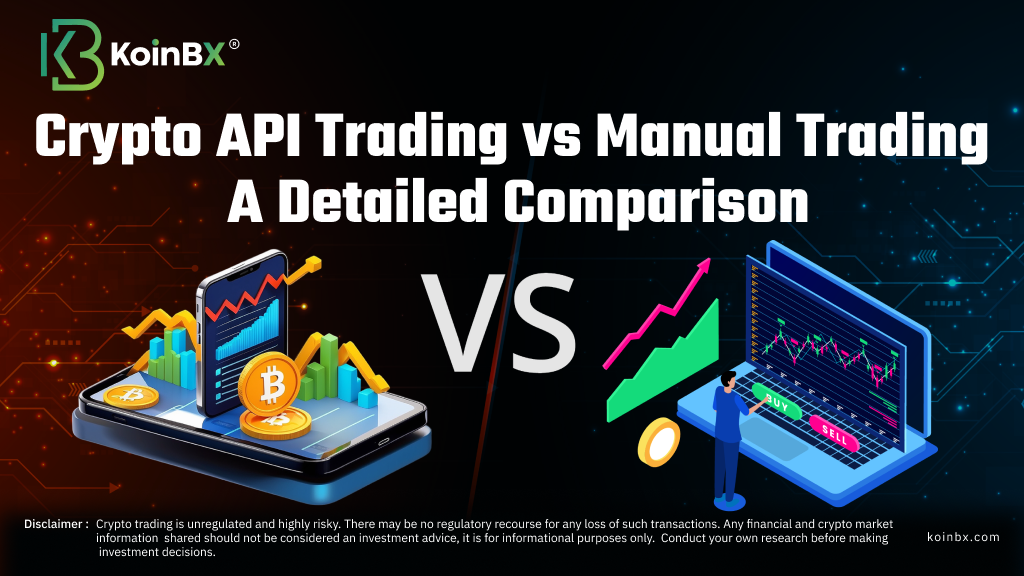n the rapidly evolving world of cryptocurrency, trading methods have diversified, offering both automated and manual options for traders. Understanding the differences, benefits, and suitable scenarios for each method is crucial for making informed decisions. This guide delves into Crypto API trading and manual trading, helping you navigate the best approach for your trading needs.
What is Crypto API Trading?
Crypto API trading refers to using Application Programming Interfaces (APIs) to automate trading activities on cryptocurrency exchanges. APIs allow traders to execute trades, access market data, and manage their accounts programmatically. This method leverages algorithms and pre-set rules to perform trades without human intervention.
Benefits of API Trading
1. Speed and Efficiency: API trading executes trades at lightning speed, which is crucial in the highly volatile crypto market. This ensures you get the best possible prices and opportunities.
2. 24/7 Trading: Unlike manual trading, API trading can operate around the clock, taking advantage of market movements at any time.
3. Elimination of Emotional Bias: Automated trading eliminates the emotional aspect of trading, adhering strictly to the pre-defined strategies.
4. Backtesting: APIs allow traders to test their strategies against historical data, improving the strategy's reliability before deploying it in real-world scenarios.
5. Scalability: API trading can handle a vast number of transactions simultaneously, making it ideal for high-frequency trading and complex strategies.
When to Choose Crypto API Trading
1. High Volume Trading: If you are dealing with large volumes of trades, API trading can handle the load more efficiently.
2. High-Frequency Trading: For strategies that require rapid execution of numerous trades within a short period, API trading is essential.
3. Complex Strategies: When using intricate algorithms that need precise execution, API trading provides the necessary precision and consistency.
4. 24/7 Market Engagement: If you want your trading strategies to operate without interruption, API trading is the way to go.
You can also read about: hodl vs staking
What is Manual Trading?
Manual trading involves human intervention in executing trades, analyzing market data, and making decisions based on personal judgment and market conditions. This traditional approach relies on the trader's expertise, intuition, and experience.
Benefits of Manual Trading
1. Flexibility: Traders can adapt quickly to changing market conditions, making intuitive decisions that an automated system might not.
2. Experience-Based Decisions: Experienced traders can leverage their knowledge and insights to make profitable trades.
3. Learning and Skill Development: Manual trading helps traders develop and refine their trading skills and strategies.
4. Immediate Reaction to News: Traders can react promptly to market-moving news and events, which might not be pre-programmed into an API.
When to Choose Manual Trading
1. Market Analysis and Strategy Development: If you are developing and testing new strategies, manual trading allows for greater flexibility and learning.
2. Emotional Intelligence: When market sentiment and emotional cues are crucial, human judgment can outperform algorithms.
3. Low-Frequency Trading: For traders who do not need to execute a high volume of trades, manual trading may suffice.
4. Personal Involvement: If you prefer to have a hands-on approach and be actively involved in your trading decisions, manual trading is suitable.
You can also read about: crypto investing vs crypto trading
Key Differences Between Crypto API Trading and Manual Trading
1. Speed: API trading is faster and more efficient, executing trades in milliseconds, whereas manual trading is slower and subject to human reaction time.
2. Emotion: API trading eliminates emotional bias, following pre-set rules, while manual trading can be influenced by emotions and personal judgment.
3. Scalability: API trading can handle a large number of transactions
simultaneously, making it ideal for high-frequency and high-volume trading, whereas manual trading is limited by human capacity.
4. 24/7 Operation: API trading operates continuously, whereas manual trading is restricted to the trader's availability.
5. Strategy Execution: API trading is suited for complex, algorithmic strategies, while manual trading is better for strategies requiring human intuition and adaptability.
In conclusion, both Crypto API trading and manual trading have their unique benefits and ideal scenarios. By understanding the key differences and advantages of each method, traders can choose the approach that best suits their needs and trading goals. Whether you prefer the speed and efficiency of API trading or the flexibility and personal involvement of manual trading, the right choice can enhance your trading success in the dynamic world of cryptocurrency.
Download KoinBX Android App | Download KoinBX iOS App
Disclaimer: Any financial and crypto market information shared should not be considered investment advice. It is for informational purposes only. Conduct your own research before making investment decisions. Crypto trading is unregulated and highly risky. There may be no regulatory recourse for any loss of such transactions.






Comments